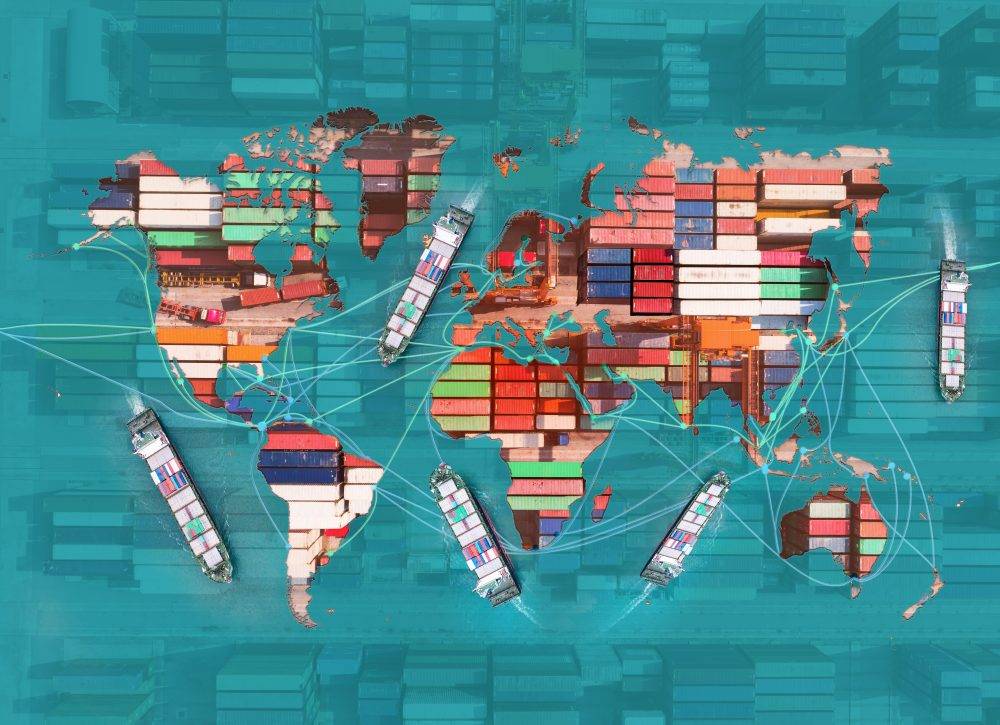Changes in the transport industry
The change in the transport intensity of the world economy is characterized by a certain stability in the post-war period: both the total freight turnover and the overall passenger turnover grew at about the same rate (with some lag) as the total gross product calculated at constant prices. During this period, the specific world freight turnover per 1 ton of manufactured goods grew by 1/3, and the per capita freight turnover and kilometric mobility of the population increased 3.5-4 times.
The main parameters of the global transport system and their dynamics are presented in Tables 1-5.
The total length of the transport network by the types of communication routes has substantially stabilized in recent decades, at the same time, there is a significant qualitative change in the network: the length of electrified and high-speed railways, highways with improved coverage, and large-diameter work pipes is increasing. Data on transportation shows the scale of the transport work: the per capita turnover for 40 years has grown from 2.8 thousand to 3.2 thousand passenger / km. One can note the dynamism of the development of transportations - the volume of transportation work has grown more than 7 times, and by 2010 it will grow by another 1.2-1.3 times.
Sea transport is sharply distinguished in world cargo turnover, the share of which has gradually increased and is still almost not reduced from 52 to 62%. The same can be said about the share in the passenger turnover of passenger car individual transport - from 57 to 60%.
There is an intensive change in the structure of transport between individual modes of transport. So, in the turnover of goods the ratio between the railway and its main competitor by road transport has changed from 4: 1 to 1.2: 1, and by 2000 their shares will be equalized. The share of pipelines increased from 4.2% to 12.8%. In passenger turnover, air transport approached the level of the railway - 10.0% and 10.2%, respectively, and by 2000 it should exceed it.
Table 1. Dynamics of the global transport system network (thousand km)
Difference and correlation between modes of transport
The most important criteria for identifying national and macro-regional differences in transport work are the following: 1) the transport intensity of production, which essentially reflects the relationship between transport and production, the size and configuration of the economic territory; 2) transport mobility of the population, reflecting the type of settlement, the degree of urbanization, the level of migration; 3) the ratio of passenger and freight traffic, which reflects the transport paradigm of a region (what is the economic system oriented on) and, finally, 4) the ratio of modes of transport in transport operations, which is the most important typological sign not only of the transport system but also of the economy in whole.
Fig. 1. World freight turnover: dynamics and structure
By all these criteria, three large groups of countries can be clearly distinguished: the industrialized Western countries, the CIS and the countries of Eastern Europe, moving from planned to market economy, developing countries in all their diversity. In 1992, the transport capacity of the economy, expressed in tkm as of 1 dollar of GDP, was 1.3 in North America, 0.3 in Western Europe, 0.4 in Japan, while in Russia 5.0, in Eastern Europe - an average of 1.5. These figures indicate the decisive importance for the level of transport capacity of the sectoral structure of the economy, the relative role of "heavy" commodity production, the socioeconomic type of the country and the relatively smaller role of the size of the territory, as indicated by the striking contrast between the countries of Western and Eastern Europe in terms of transport capacity 5 times). As for the developing countries, then, as might be expected, the importance of transport capacity varies considerably from 0.84 in the most economically backward countries to 1.7 in Latin American countries.
Fig. 2. Worldwide passenger turnover: dynamics and structure
The indicator of mobility of the population has the opposite tendency - its highest value in the industrially developed Western countries. The per capita inter-city passenger turnover, expressed in thousand passenger / km, in North America is 12.9, in Western Europe - 8.5, in Japan - 6.3, while in Russia - 3.6, and in Eastern Europe - total 2.9. Transport mobility of the population is a complex social and economic phenomenon, behind which stands a whole complex of cultural, political and demographic factors.
Overall, the transport business is changing a lot, and integrating with trading by the means of digital payments.
Table 2. World freight turnover by mode of transport
The issue of motorization of the population is closely connected with the problem of mobility. The growth of motorization is one of the most stable dynamic and inelastic processes within the framework of the development of mankind in the post-war period, which in many ways determines the differences in the level of mobility. This indicator for developing countries also varies considerably and is generally relatively low, as it reflects only travel by mechanical modes without taking into account cycling and walking movements - in the most economically backward countries - 0.65, and in North Africa - 2.0, in Latin America - 1.5.
Table 3. Worldwide passenger turnover (out-of-town) by mode of transport
An important typological criterion reflecting the transport paradigm of the economic system is the ratio of freight and passenger traffic (1 tkm by "weight" equals 1 passenger / km), with all the conventionality of such comparisons. Here we proceed from two-product (freight and passenger) transport. Of course, this ratio is closely correlated with the levels of transport capacity and mobility given above. This ratio for the United States is 1.2 (that is, in absolute terms, the total freight turnover is 1.2 times the total long-distance passenger turnover), for Western Europe 0.34, for Japan 1.1, for Russia 7.8, for Eastern Europe Europe 3.53, in developing countries - from 0.4 in the least developed countries, to 2.5 in North Africa. To a large extent this ratio, as well as mobility, is influenced by the development of tourism and the entire recreational area in the region or a single country.
Table 4. Distribution of domestic intercity freight turnover by mode of transport in 1993 (%)
And, finally, the ratio of modes of transport in freight transport is determined by the composition of the freight-forming branches of the economy, the degree of territorial concentration of production. The industrialized countries of the West and the East account for about 80% of the world's inland freight (without sea) transport, which is divided almost equally between the two groups of countries. However, the ratio of modes of transport has, it can be said, fundamental differences. In the western countries as a whole, railway transport accounts for 25%, motor transport accounts for 40%, and the remaining 35% for inland water, sea cabotage and pipeline. In the CIS and in Eastern Europe as a whole, railways dominate freight turnover - about 60% on average, while only 9% for road transport. In North America, the share of rail and road transport in freight turnover has almost equaled, while in Russia they are 46 and 9%, respectively. The huge gap in the cost of rail and road transport (15-fold) objectively hinders the development of road transport there, while in the US the gap in the cost price is only 4-fold. Such differences are in turn due to a number of factors: the poor development of the road network and its low quality (the share of roads with a capital covering in Russia is less than 1/3, while in the USA it is more than 60% with a 6-fold total length), the structure of a truck fleet (in Russia, medium-tonnage cars still prevail, which determines the low loading of the park), etc. Even more striking are the differences between the share of rail and road transport in the countries of Western and Eastern Europe - respectively 19 and 67, 78 and 9%.
Table 5. Distribution of intercity passenger turnover by mode of transport in 1993 (%)
In developing countries, rail, road transport and pipelines account for an average of almost 1/3 of the total domestic cargo turnover (in Latin America, the share of road transport is much higher - 65%, and in Asia - lower).
Almost 90% of the freight turnover of air transport falls on the industrialized countries. The share of this type of transport in the total cargo turnover of CIS is 12 times lower than in the North America freight turnover, although absolutely these shares are quite small in both cases - 0.04 and 0.5%, respectively.
According to the latest data, about 50% of the adult population of CIS does not go on vacation during the holidays. The lack of a developed road network, low level of road transport, both bus and especially passenger cars, become a serious obstacle in the development of the recreational sector. Air passenger turnover, in spite of its high share, is inferior to the American one by 3.5 times, Western European - by 1.5 times. These changes and differences are caused by a number of factors that can be connected into four groups, mentioned before in Table 5.
Don't forget to subscribe to our Telegram Channel and view the most comprehensive shipping matters, as well as saying out loud in our shipping chat.
Related links:

